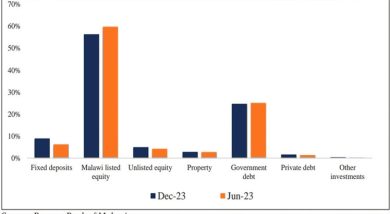February inflation rate rises to 26.7%—NSO
Malawi’s year-on-year headline inflation rate continues to rise, hitting 26.7 percent in February 2023, figures from the National Statistical Office (NSO) show.
This is a 0.8 percentage point increase from 25.9 percent registered in the previous month.
The increase has been explained by a 1.2 percentage point rise in food inflation rate to 31.7 percent in February from 30.5 percent in the preceding month.
On the other hand, non-food inflation rate declined by 4.9 percentage points from 25.4 percent in January to 20.5 percent in February, according to NSO.
This means that prices of food items increased at a higher rate in February compared to January while prices of non-food items slowed in February compared to January.
Speaking in an interview on yesterday, Consumers Association of Malawi executive director John Kapito said most Malawians are going through hard times as inflation continues to rise.

He said: “Worse off are those that have no means of income while demand for basics, especially food, is growing. It is one of the worst economic nightmares for consumers.”
In Malawi, maize, as part of the food component, accounts for about 52 percent in the consumer price index, which is an aggregate basket of goods and services for computing inflation.
Meanwhile, the Reserve Bank of Malawi (RBM) has said prevailing inflation levels are not conducive to support economic growth projected at not more than 2.7 percent in 2023, a rebound from the previous year’s 1.2 percent.
In its Monetary Policy Committee report in February, the central bank said although it projects headline inflation to slow down to 18.2 percent from 21 percent last year, it maintained the policy rate at 18 percent to facilitate the downward trajectory for inflation to the growth-enhancing single-digit rates.
This year, RBM projects headline inflation to slow down to 18.2 percent from 21 percent last year due to anticipated subdued imported inflationary pressures although pressure on domestic prices remains elevated in the wake of the lean season.
The statement further said pressures are expected to remain high for domestically produced food commodities, particularly cereals, due to high costs of farm inputs such as fertiliser, which has affected access of the commodity for crop production.
However, it said the 2023 inflation rate projection is on account of declining key imported commodities, which is easing imported inflation and also the heightening risk of a global recession amid tight financial and monetary conditions.





